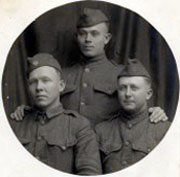
Carol’s grandfather, I. G. Coley, in the center with two of his buddies. This was probably taken during training at Camp Travis in San Antonio, Texas or in New York prior to debarkation. The men left the U. S. in June 1918 and returned to the United States one year and one day later.
Last weekend I made a presentation to the East Texas Genealogy Society in Tyler. It was the second of a series on World War I. This one is called Military Records for the Great War. Believe me, thousands, if not millions, of records exist.
Most military units have associations for former members, similar to the Grand Army of the Republic (GAR) during the Civil War. My interest lies in Company C, 315th Engineers, 90th Division. At the end of the Great War, the War Department required the captain of each company to write a summary of their duties and experiences during the war. Since Company C lost their captain toward the end of fighting, I had to rely on the report for Company A.
The actions of the two groups were not identical but very similar. The report began when they arrived at Camp Travis in San Antonio for training. Engineers received both infantry and engineering training. Troop trains leaving San Antonio for the East Coast zigzagged around the country on the way to New Jersey. Why I don’t know, but German submarines were lying in wait off the East Coast, particularly around Nantucket Island.
The trip across the Atlantic was uneventful since the troops enjoyed a fine British ocean liner cruise. The transportation from Liverpool to La Havre in France was more traumatic with choppy seas on a much smaller ship. Once ashore, American troops were treated with food, flowers, kisses, and wines. France knew the war would soon be over with Americans to break the stalemate in the trenches.
I was particularly interested in what duties member of the 315th Engineers did during the war. My grandfather was a corporal in Company C. He often told me about his experiences after the war, but never mention the time before November 11, 1918.
Engineers were tasked with building or repairing roads, laying or cutting through barbed wire, and scavenging through materials left behind by the retreating German Army. Some of the items were rigged to explode when a Yank picked them up, such as a shiny new fountain pen that killed a private. Engineers built shelters and set up camp kitchens. They were the carpenters and road builders of the army.
Since engineers were trained for combat, they carried a rifle and gas mask. At the end of the war, a gas mask was in use much of the time. But because they weren’t required to go over the top (climb out of the trenches and charge the enemy), engineers had a much smaller death rate.
No one escaped the mud and rain and cold. Most of the men in the 90th Division came from Texas and Oklahoma. While it gets cold in the Texas panhandle and most of Oklahoma, those spots seldom see heavy snow in October.
By 1918, much of the war was fought with artillery. As “latrine rumors” or gossip spread through the armies that the end was in sight, every artillery battery on both sides of No Man’s Land wanted to claim to have fire the last round. The report I read stated that the last round was fired at 10:59 on the morning of November 11. The truce began at eleven o’clock on the eleventh morning of the eleventh month. It suddenly seemed so very quiet. By afternoon birds began to sing. But the Americans, French, British and Belgians continued to chase the enemy into Germany. American forces served in the Army of Occupation in Germany until 1925.
